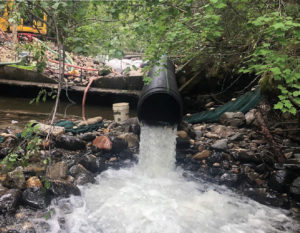Okanagan Hydrometric Information Network Program
Recently, the Board adopted the Terms of Reference for an Okanagan Hydrometric Information Network Program to respond to the long-recognized deficit of hydrometric monitoring stations in the valley. The goal of this program is to increase the number of stations and improve data access from existing stations, in partnership with Okanagan Nation Alliance (ONA), senior governments and Okanagan water suppliers. Learn more here.
What is a hydrometric station?
A hydrometric station is a data collection tool on a river, lake, estuary, or reservoir where water quantity (and sometimes quality) is collected and recorded.

Although water availability has long been a problem in the Okanagan and supply problems are predicted to worsen, the basic network of hydrometric stations has been declining for several years. Only 15 of the 79 drainages in the Okanagan Basin are now being monitored by the Water Survey of Canada.
Reliable data is needed for water management planning by local governments, water purveyors, and the agricultural community.
This data is used for:
- land-use and transportation planning
- flood forecasting
- drought management planning
- protecting in-stream flows for fish, and
- tracking changes in streamflow, water temperature and other indicators in relation to population growth and climate change.
Water Flow Monitoring Projects supported by the OBWB Water Conservation and Quality Improvement (WCQI) grant program:
- Hydrometric Monitoring – Peachland and Trepanier Creeks
Project Year: 2020 | Organization: District of Peachland - Establishing a Syilx Framework to Implement Environmental Flow Needs
Project Year: 2020 | Organization: Okanagan Nation Alliance - Irrigation Connection Point Retro-fit Project Phase 2
Project Year: 2018 | Organization: City of Kelowna - Pearson Creek Hydrometric Station
Project Year: 2016 | Organization: Black Mountain Irrigation District - N’Soosoolowx Watershed Corridor Improvement
Project Year: 2017 | Organization: Sqilxw Apna Society - Hydrometric Monitoring – Powers Creek
Project Year: 2007 | Organization: Westbank Irrigation District - Managing Water Levels on Ellison Lake
Project Year: 2007 | Organization: Oceola Fish and Game Club - Hydrometric Monitoring – Curtis Creek, Heart Creek and Duteau Creek
Project Year: 2007 | Organization: Greater Vernon Water - Hydrometric Monitoring – Penticton Creek and Ellis Creek (3 Grants)
Project Year: 2006 | Organization: City of Penticton - Mission Creek Station Enhancement
Project Year: 2006 | Organization: Black Mountain Irrigation District
Hydrometrics Resource Library
- Map of Hydrometric Network in the Okanagan Basin
- Audit of the National Hydrometric Program (2010)
- Hydrometric network requirements for the Okanagan Basin (Dobson 2008)
Background
In 2008, the OBWB and BC Ministry of Environment commissioned a study to determine the location of hydrometric monitoring stations essential to long-term water management in the Okanagan Basin. Their importance is underscored by an audit of the National Hydrometric Program (2010) which found that hydrometric monitoring has significant value to our environment and economy.
Further reading:

